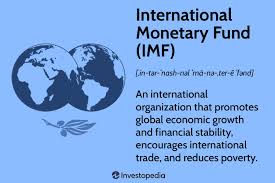Say Goodbye To The Dollar
The IMF Prepares A Financial Revolution
Global reserve currency status allows for amazing latitude in terms of monetary policy.
The Treasury Department understands that there is constant demand for dollars overseas as a means to more easily import and export goods. The petrodollar monopoly made the U.S. dollar essential for trading oil globally for decades.This means that the central bank of the U.S. has been able to create fiat currency from thin air to a far higher degree than any other central bank on the planet while avoiding the immediate effects of hyperinflation.


IMF Prepares Financial Revolution – Say Goodbye To The Dollar
Authored by Brandon Smith via The Burning Platform blog,
Global reserve currency status allows for amazing latitude in terms of monetary policy.
The Treasury Department understands that there is constant demand for dollars overseas as a means to more easily import and export goods. The petrodollar monopoly made the U.S. dollar essential for trading oil globally for decades.
This means that the central bank of the U.S. has been able to create fiat currency from thin air to a far higher degree than any other central bank on the planet while avoiding the immediate effects of hyperinflation.
Much of that cash as well as dollar-denominated debt ends up in the coffers of foreign central banks, international banks and investment firms. Sometimes it is held as a hedge, or bought and sold to adjust the exchange rates of local currencies. As much as 60% of all U.S. currency (and 25% of U.S. government debt) is owned outside the U.S.
Global reserve currency status is what allowed the U.S. government and the Fed to create tens of trillions of dollars in new currency after the 2008 credit crash, all while keeping inflation more or less under control.
The problem is that this system of stowing dollars overseas only lasts so long and eventually the effects of overprinting come home to roost.
The Bretton-Woods Agreement of 1944 established the framework for the rise of the U.S. dollar. While the benefits are obvious, especially for the U.S., there are numerous costs involved. Think of world reserve status as a “deal with the devil.” You get the fame, you get the fortune, you get trophy dates and a sweet car – for a while. Then one day the devil comes to collect, and when he does he’s going to take everything, including your soul.
Unfortunately, I suspect collection time is coming soon for the U.S.
It may take the form of a brand-new Bretton Woods-like system that removes the dollar as global reserve currency and replaces it with a new digital basket system. (Something like the International Monetary Fund (IMF)’s Special Drawing Rights (SDR) currency.)
Global banks are essentially admitting they plan for a complete overhaul of the dollar-based financial world, and the creation of a central bank digital currency (CBDC)-focused system built on “unified ledgers.”
There have been three recent developments all announced in succession that suggest the dollar’s replacement is imminent.
And by “imminent,” I mean before this decade is over.
The IMF’s XC framework: A centralized policy For CBDCs
The IMF’s XC platform was released as a theoretical model in November of 2022 and matches closely with their long discussed concept of a global SDR, only in this case it would tie together all CBDCs under one umbrella along with “legacy currencies” (dollars and euros and so on).
XC is marketed as a policy structure to make cross-border payments in CBDCs “easier” for governments and central banks. Of course, it places the IMF as the middleman controlling the flow of digital transactions. The IMF suggests that the XC platform would make the transition from legacy currencies to CBDCs easier for the various nations involved.
As the IMF noted in a discussion on centralized ledgers in 2023:
We could end up in a world where we have connected entities to some degree, but some entities and some countries that are excluded. And as a global and multilateral institution, we’re sort of aiming to, you know, provide a basic connectivity, a basic set of rules and governance that is truly multilateral and inclusive. So, I think that is – the ambition is to aim for innovation that is compatible with policy goals and that is inclusive relative to the broad membership of, say, the IMF.
To translate, decentralized systems are bad.
“Inclusivity” (collectivism) is good.
And the IMF wants to work in tandem with other globalist institutions to be the “facilitators” (controllers) of that economic collectivism.
Bank For International Settlements (BIS)’s Universal Ledger
Not more than a day after the IMF announced their XC platform goals, the BIS announced their plans for a single record for all CBDCs called the BIS Universal Ledger. The BIS specifically notes that the project is meant to inspire trust in central bank digital currencies while overcoming the fragmentation of current tokenization efforts.
While the IMF is focused on controlling international policy, the BIS is pursuing the technical aspects for the globalization of CBDCs. Both make it clear in their white papers that a cashless society is in fact the end game and that digital transactions must to be monitored by a centralized entity in order to keep money “secure.”
As the BIS argues in their extensive overview of Unified Ledgers:
Today, the monetary system stands at the cusp of another major leap. Following dematerialisation and digitalisation, the key development is tokenisation – the process of representing claims digitally on a programmable platform. This can be seen as the next logical step in digital recordkeeping and asset transfer…
The blueprint envisages these elements being brought together in a new type of financial market infrastructure (FMI) – a “unified ledger”. The full benefits of tokenisation could be harnessed in a unified ledger due to the settlement finality that comes from central bank money residing in the same venue as other claims. Leveraging trust in the central bank, a shared venue of this kind has great potential to enhance the monetary and financial system.
There are three major assertions made by the BIS in their program:
First, the digitization of money is unavoidable. Cash is going to disappear primarily because it makes moving money easier, and existing cryptocurrencies are “a flawed system that cannot take on the mantle of the future of money.”
Second, our existing decentralized payment methods are unacceptable because they are “risky.” Only central banks are qualified and “trustworthy” enough to mediate the exchange of money.
Third, the use of Unified Ledgers is largely designed to track and trace and even investigate all transactions (for the public good, of course).
The BIS system deals far more in the realm of private transactions than the IMF example. It is the technical foundation for the centralization of all CBDCs, governed in part by the BIS and the IMF, and it is scheduled to go into wider use in the next two years.
There are already multiple nations testing the BIS ledger today.
Now, it’s important to understand that whoever acts as the middleman in global money exchange is going to have all the power, over both governments and their citizens.
In other words, whoever controls the unified ledger also controls all the world’s money.
If every movement of wealth is monitored, from the shift of billions between governments down to your payment for groceries and gas, then every single transaction can be rejected.
Your access to food and fuel would depend on the whim of the observer. Which might not even be human…
Historically, such granular control over individual transactions hasn’t been possible. Numbers vary, but the average American currently makes 39-70 transactions per month, 1-2 per day. The development of AI makes it possible to assess and analyze massive amounts of data in real-time and to develop very detailed profiles of individuals simply based on their purchases… And, of course, to identify and prevent anti-social purchasing behavior in real-time.
The SWIFT Cross Border Project (another way to control entire nations)
As we’ve seen with the attempt to use the SWIFT payment network as a bludgeon against Russia, there is an obvious motive for globalists to control a high-speed large-scale transaction hub. Again, this is all about centralization, and whoever controls the hub has the means to control trade… up to a point.
Locking Russia out of SWIFT didn’t work, though, did it?
The Russian economy suffered minimal damage exactly because there are other methods for transferring money between nations to keep the flow of trade running. However, under a CBDC based global monetary umbrella, it would be impossible for any country to work outside the boundaries. It’s not only about the ease of shutting a nation out of the network, it’s also about having the power to immediately block the transfer of funds on the receiving end of the exchange. (Just like in the example above.)
Any funds from any source could be intercepted before reaching their recipient.
Once governments are completely under the thumb of a centralized monetary system, a centralized ledger and a centralized exchange hub, they will never be able to escape.
This control will inevitably trickle down to the general population.
Does this sound nuts? Here’s the really scary part: The vast majority of nations are going right along with this program!
China is most eager to join the global currency scheme.
Russia is still part of the BIS, but their involvement in CBDCs is still unclear.
The point is, don’t expect the BRICS to counteract the new monetary order. It’s not going to happen.
CBDCs automatically end the dollar’s global reserve currency status
So what do all these globalist projects with CBDCs have to do with the dollar?
The bottom line is this: A unified CBDC system excludes the need or use-case for a global reserve currency entirely.
The Unified Ledger model takes all CBDCs and homogenizes them into a pool of liquidity, each CBDC growing similar in characteristics over a short period of time.
The dollar’s advantages disappear in this scenario. The value of all currencies becomes relative to the middle-man. In other words, the IMF, BIS and other related institutions dictate the properties of CBDCs and thus there is no distinguishing aspect of any individual CBDC that makes one more valuable than the others.
Sure, some countries might be able to separate their currency to a point with superior production or superior technology. But the old model of having a big military as a way to prop up your currency is dead.
All the world’s currencies, from dollars to Malaysian ringgit, would become nothing more than line items on the Universal Ledger.
Eventually the globalists will make two predictable arguments:
1) A world reserve currency under the control of one nation is unfair and we as global bankers need to make the system “more equal.”
2) Why have a reserve currency at all when all transactions are moderated under our ledger anyway? The dollar is no better for international trade than any other CBDC, right?
Finally, the dollar has to die because it’s an integral part of the “old world” of material exchange. Remember, originally the dollar was defined as “three hundred and seventy-one grains and four sixteenth parts of a grain of pure silver.” Tangible assets like physical precious metals have no place in the purely digital future the globalists envision.
The globalists desire a cashless society because it is an easily controlled society. Think of the Covid lockdowns – if they had a cashless system in place at that time, they would have gotten everything they wanted. Refuse to take the experimental vaccine? We’ll just shut off your digital accounts and starve you into compliance.
Without physical money, you have no alternative unless you plan to live completely off the land and barter goods and services (a way of life most people in the first world need a lot of time to get used to).
I believe that a sizable percentage of the American populace would resist a cashless society, but in the meantime, there is still the inevitability of a dollar crash to deal with. Globalist organizations are pushing CBDCs to go active very quickly, and this plus centralized ledgers will dethrone the dollar.
This means that those trillions in greenbacks held overseas will start flooding back into America all at once, causing a historic inflationary disaster.
Exactly the kind of disaster that might convince the nation to accept a new, digital currency…
As much as our nation has benefited from global reserve currency status in the past, it will suffer equally as the dollar dies.
That’s one reason it’s absolutely crucial to own physical precious metals. Untrackable, non-digital forms of money like gold and silver will be even more highly prized in the near future than they are today.
* * *
With global instability increasing and election uncertainties on the horizon, protecting your retirement savings is more important than ever. And this is why you should consider diversifying into a physical gold IRA. Because they offer an easy and tax-deferred way to safeguard your savings using tangible assets. To learn more, click here to get your FREE info kit on Gold IRAs from Birch Gold Group.






